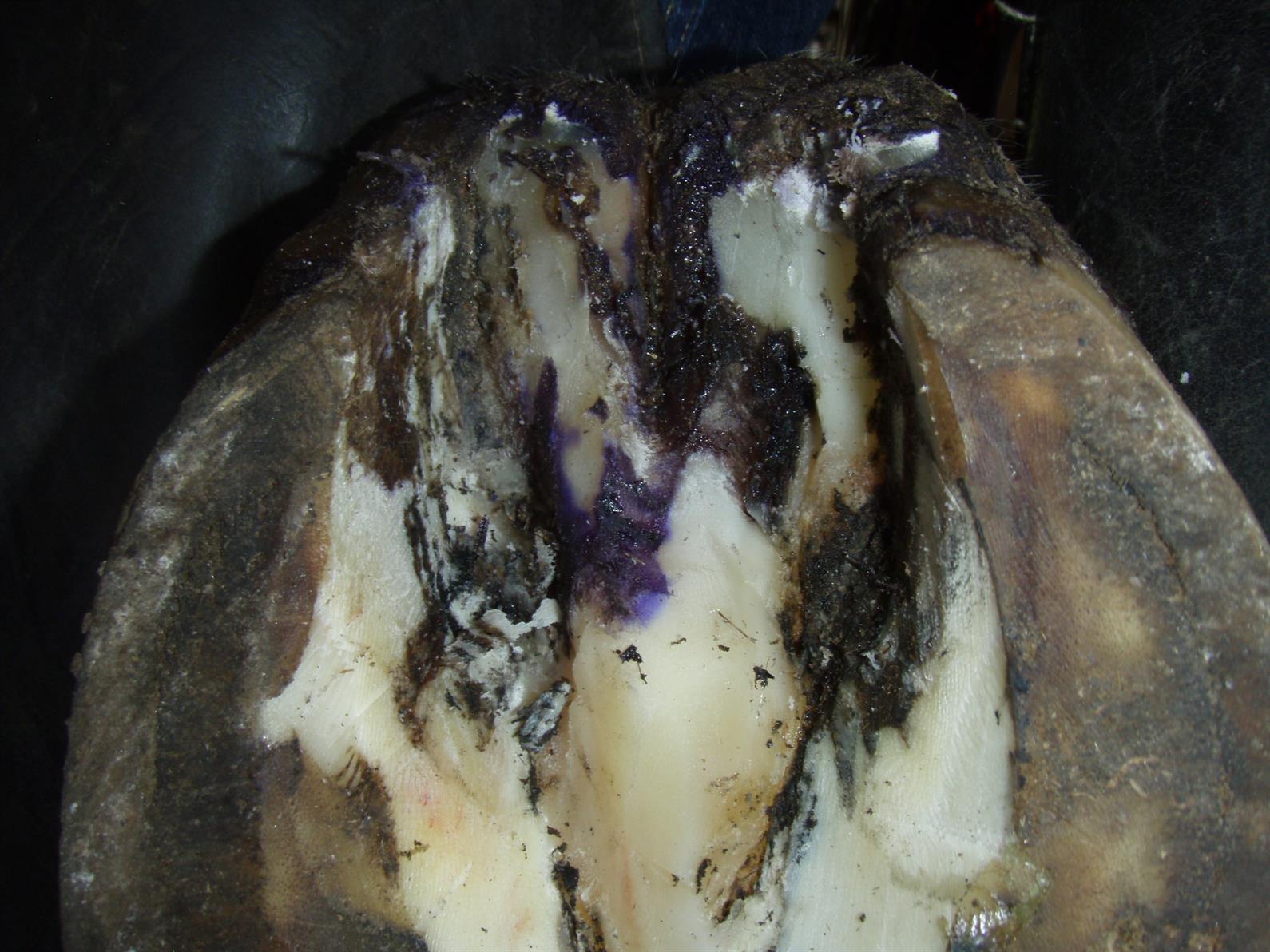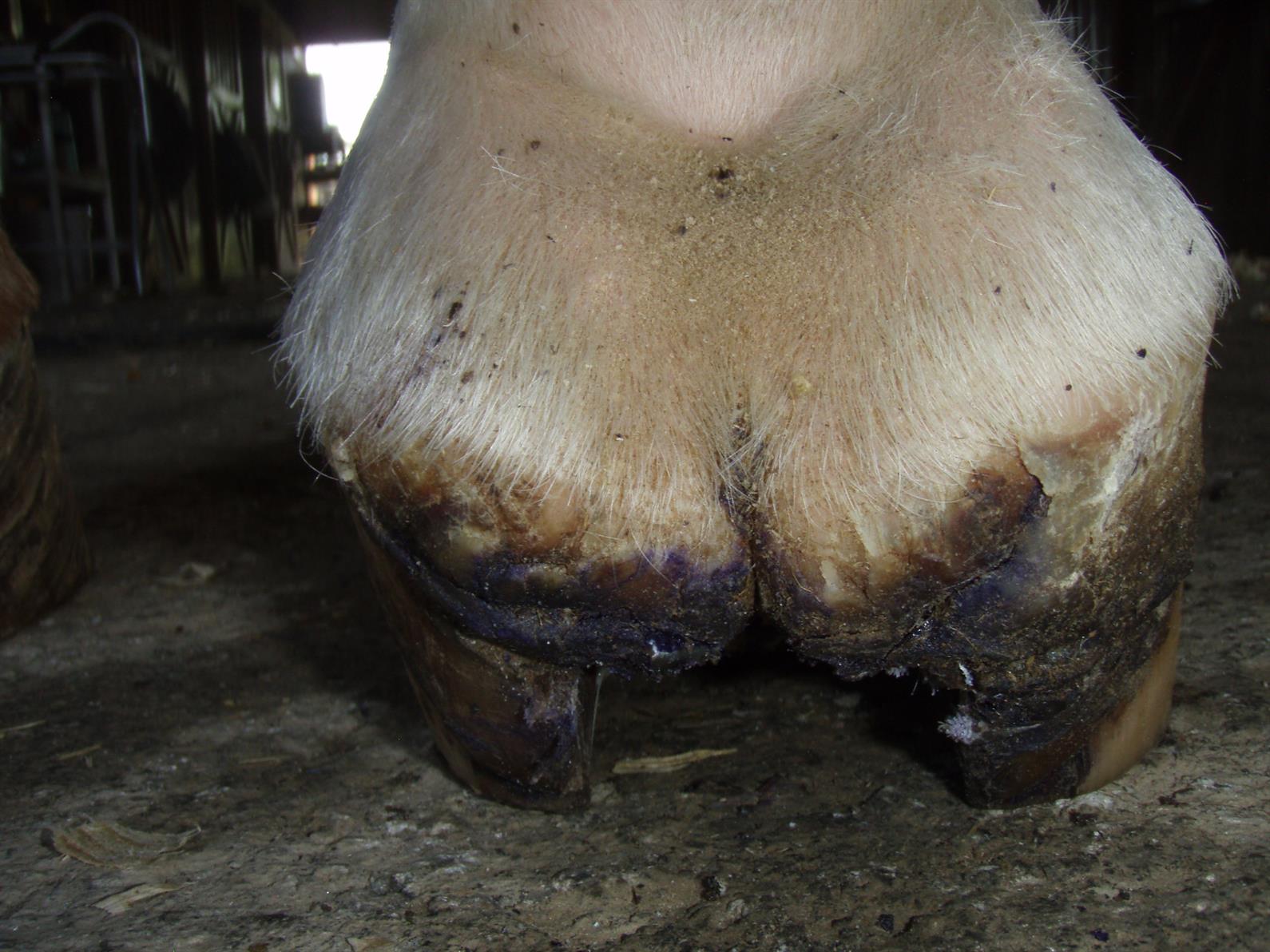It’s a scenario every horse owner dreads: a runny, black, foul-smelling discharge around the frog area of a horse or pony’s hoof sole. That’s the classic sign of thrush, a bacterial infection that involves the frog, including the grooves on either side of it and the cleft between the heel bulbs.
“It can affect any part of the frog, but that’s where we see it the most, right where the owner would be using the hoof pick along the sides of the frog and along that little cleft between the heel bulbs,” said Dr. Bryan Fraley of Fraley Equine Podiatry at Hagyard Equine Medical Institute. “One of the most common bacterial agents that has been isolated for thrush is Fusobacterium necrophorum. Thrush is an opportunistic thing. In a normal, healthy hoof in reasonable condition, it doesn’t seem to happen or, at least, it doesn’t become a problem.”

A healthy hoof helps clean itself out, Fraley explained.
“The normal foot is slightly concave and the laminae that attach the coffin bone to the hoof wall are slightly elastic,” he said. So when the horse bears weight, that pushes the surface of the hoof sole slightly outward so that it because flat or even slightly convex.
“That’s a natural, self-cleaning mechanism,” Fraley said. “Normal turnout and regular exercise help that, so a horse that’s not getting out enough or who is standing around in a stall can be at some risk for thrush. If a horse does have to be in, it’s important to pick its feet out rather than let it stand with a lot of sawdust or organic material packed in there.
“Thrush can be a sign of some type of abnormality in the foot,” Fraley explained, “either a lameness in which the horse isn’t putting enough weight in the foot to allow the foot to clean itself out or perhaps the foot hasn’t been trimmed in a way to allow the foot to help clean itself out. Or it can be a sign of poor hygiene. If the horse has been standing in unsanitary conditions, even if the foot cleans itself out, it just goes right back into mud and poop and organic material.”
Horses with navicular disease also can be at increased risk for thrush. “That foot isn’t functioning normally, and maybe the horse is guarding its foot and the heels are contracting secondary to pain,” Fraley explained. “The cleft of the frog gets a little deeper and bacteria get in there and can digest down to sensitive tissue. But usually if thrush causes lameness, it’s because the thrush is severe.”
For horses who wear pads as part of a shoeing package or a treatment for lameness, Fraley said, “Often, farriers will pack under there with medicated sole packs. There are also silicones available that can fill in that void, but that, too, can trap moisture and air, so a lot of farriers will dust the foot with copper sulfate granules or powder before putting the silicones in there. That’s a good practice.
“I’m a fan of natural materials, like leather pads, and I’ll pack under those leather pads with medicated sole pack,” he added.
If dealt with early, thrush can be simple to treat, Fraley said, before it ever causes lameness or more serious issues.
“But if it’s ignored, that’s when you can get into trouble,” he said. “Thrush doesn’t cause lameness until it eats away at the frog and gets down to sensitive tissue. Then it can cause lameness.”

The most common source of really severe thrush is in the cleft between the heel bulbs, called the central sulcus, which runs down the center of the frog. In some cases, thrush can create a deep gash there that can be cleaned out with gauze and antiseptics as part of the treatment, Fraley said.
Treatment can involve your farrier or veterinarian trimming the frog and any ragged edges that might harbor bacteria and soaking the foot in a chlorine-based solution. It’s important not to use a substance that’s too caustic, Fraley warns. Strong iodines, for example, might be too much for a thrush case that has already eaten into sensitive area.
“You don’t want to dry and irritate sensitive tissue, especially if the thrush already is involving sensitive tissue,” he said.
Consult your veterinarian before choosing a product to make sure you’re getting the best available treatment for your horse.
Thrush can be mistaken for canker. “Canker can be more serious,” Fraley said. “It’s a proliferative condition, which means it isn’t so much digesting away the frog the way thrush does but actually growing. It’s a tumor-like growth of the frog that is nasty-smelling, but it has more of a cauliflower color and texture. It starts small and grows.”
If your horse’s frog has an area you’re wondering about, Fraley says, ask your farrier. “They pick up thousands of feet, and they’re probably going to lead you in the right direction in terms of when to call the veterinarian, too.”
There are steps you can take to help your horse avoid getting thrush. Here are some to consider:
- Regular turnout and exercise. This helps the hoof to self-clean.
- Clean your horse’s feet out regularly. Frequent use of a hoof pick helps keep organic material from packing into his feet and creating fertile ground for thrush. “And when horses come in from the pasture, pick their feet before the go into the stall,” Fraley said. “Otherwise, they’re just standing on manure that might have been in their feet.”
If your horse’s feet are sensitive when you pick them out, Fraley recommends calling your vet.
- Keep his stall clean and dry. A stall that stays damp and dirty sets up a good environment for thrush, exposing your horse’s hooves continually to wet organic material.
- Consider a bedding change. “Sometimes the best-cared-for horses in the best barns will get this, because their feet are constantly moist from getting bathed frequently and they’re bedded on straw,” Fraley said. “Sometimes switching a horse to shavings can help, because shavings or wood chips will dry out a little more and can help the foot dry, as long as the owners are picking out the feet regularly. Some of the hardest feet we’ll trim as farriers are horses that are bedded on shavings or sawdust.
“It’s not that horses bedded on sawdust or shavings won’t get thrush,” he added. “But if you’re having a problem, sometimes a bedding change to straw might also help.”
In part two of this two-part Hoof Help series, Fraley describes what makes white line disease “insidious” and how you can help prevent it from weakening your horse’s hooves.
Want more articles like this delivered to your inbox every week? Sign up here to receive our free Equestrian Weekly newsletter.
This article is original content produced by US Equestrian and may only be shared via social media. It is not to be repurposed or used on any other website aside from usequestrian.org.


